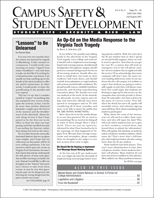Campus Safety and Emergency Management for the Special Mission and Unique Challenges of Community Colleges
Author: Matt McGraw.; Dennis E. Gregory.
Source: Volume 19, Number 01, Fall 2017 , pp.3-10(8)

< previous article |next article > |return to table of contents
Abstract:
Campus safety, emergency management, and emergency preparedness have become significant areas of responsibility for institutions of higher education. These institutions have increasingly been seen as having commitments, both implicit and explicit, to provide for the safety of students, faculty, staff, and other constituents on the campuses. Community colleges, which educate nearly half of all undergraduates in the United States play a unique role in the communities that they serve. While often characterized by a broad academic mission and commitment to access for all students, community college leaders are increasingly faced with challenges related to crisis management, emergency preparedness, campus violence, threat assessment, and compliance with Title IX on their campuses. This article presents a brief overview of selected topics related to crisis management at community colleges. The traditional mission of community colleges is considered within the context of emergency planning and mitigation. Compliance with legislation such as the Clery Act and Title IX are addressed, the role of threat assessment or behavioral intervention teams on community college campuses is discussed, sample emergency management plans and models are presented, and an interview with a professional working in the field offers additional practical insights.Keywords: Community College Security; Title IX and Clery Act Compliance; Gun Violence; Threat Assessment Teams; “All Hazards” Emergency Management
Affiliations:
1: Lancaster Community College; 2: Old Dominion University.